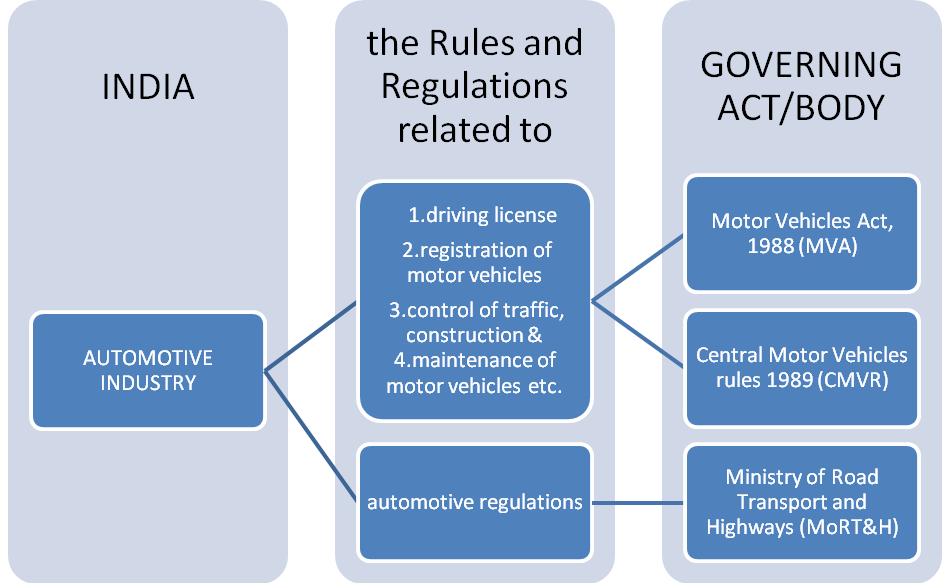Ministry of Road Transport and Highways (MoRT&H)
In order to involve all stake holders in regulation formulation, MoRT&H has constituted three Committees to deliberate and advise Ministry on issues relating to Safety and Emission Regulations, namely
1. CMVR – Technical Standing Committee (CMVR-TSC): It advises the Ministry on various Technical aspects related to CMVR. Its members are represented by
- Ministry of Heavy Industries & Public Enterprises (MoHI&PE)
- MoRT&H
- Bureau of Indian Standards (BIS)
- Testing Agencies such as Automotive Research Association of India(ARAI)*
- Vehicle Research and Development Establishment (VRDE)
- Central Institute of Road Transport (CIRT)
- industry representatives from Society of Indian Automobile Manufacturers (SIAM)
- Automotive Component Manufacturers Association(ACMA)
- Tractor Manufacturers Association(TMA)
- Representatives from State Transport Departments.
2. Automotive Industry Standards Committee (AISC): CMVR-TSC is assisted by another Committee called the AISC having members from various stakeholders in drafting the technical standards related to Safety.
3. Standing Committee on Implementation of Emission Legislation (SCOE): This Committee deliberates the issues related to implementation of emission regulation.
*Under Rule 126 of the CMVR, various test agencies are established to test and certify the vehicles based on the safety standards and emission norms prescribed by the Ministry.
Every manufacturer of motor vehicle has to submit a prototype of the vehicle to be manufactured to any of the test agencies mentioned hereafter. After testing the vehicle for compliance of all standards and norms, the test agency shall grant a certificate to the manufacturer.
The test agencies are –
- Automotive Research Association of India, Pune (ARAI),
- Vehicle Research & Development Establishment, AhmedNagar,
- Central Farm Machinery Testing and Training Institute, Budhni,
- Indian Institute of Petroleum,Dehradun,
- Central Institute of Road Transport, Pune and
- International Centre for Automotive Technology,Manesar.
Functions
The various functions of the three committees have been tabulated below:
|
FUNCTIONS OF CMVR-TSC
Central Motor Vehicle Rules –Technical Standing Committee |
FUNCTIONS OF AISC
Automobile Industries Standing Committee
|
FUNCTIONS OF SCOE
Standing Committee on Implementation of Emission Legislation (SCOE) |
|
|
|
|
|
|
|
|
|
|
· Recommend commissioning of testing facilities at appropriate stages
|
|
|
· Recommend the necessary funding of such facilities to the CMVR Technical Standing Committee | |
|
|
How does it work?
STEP 1
| AISC submits the draft safety standards in the form of recommendations to CMVR-TSC for final approval.
The National Standards for Automotive Industry are prepared by Bureau of Indian Standards (BIS). The standards formulated by AISC are also converted into Indian Standards by BIS. |
STEP 2
| The standards formulated by both BIS and AISC are considered by CMVR-TSC for implementation and either approves or sends the recommendations to AISC for amendments. |
STEP 3
| After approval CMVR-TSC submits its final proposal to Mo RT&H. |
STEP 4
| Mo RT&H then takes the final decision for incorporation of the recommendations in CMVR. |
STEP 5
| The Automotive Industry Standards are published by the Automotive Research Association of India on behalf of the Automotive Industry Standards Committee. |
Challenges And Problems
- India is the country with the highest number ofdeaths due to road accidents in the world.
- India is the world’s sixth-largest car market, but is still the only country in the global top ten car markets which does not have a proper car safety regulation or testing programme.
- Indian automotive industry is where European countries were 20 years back in terms of safety. While the use of seatbelts is compulsory, the enforcement of these laws is poor resulting in only 27% of drivers complying with the law which aggravates the problem.
- All the bodies involved in formulating vehicle norms are under the control of the automotive manufacturers
- Instead of having a single central body, there are numerous ministries and bodies involved.
Recent Developments
- It has been suggested that an IndianNew Car Assessment Program (NCAP) should be set up urgently, jointly by a foreign body, the government and the industry itself.
- In May 2014, it was reported that the introduction of the Bharat New Vehicle Safety Assessment Program (BNVSAP) was being planned.
- After the interim order of the Guwahati High Court to ban small cars in Assam, Global NCAP had requested Indian carmakers to adopt United Nations safety standards for front and side impact from January 1, 2015.
- In a letter to the Society of Indian Automobile Manufacturers (SIAM), the global crash-test safety agency has suggested automakers to take voluntary initiative on car safety instead of waiting for the Indian government’s new occupant protection regulations under Bharat New Vehicle Safety Assessment Programme (BNVSAP).
- According to them, it’s not really tough for Indian automakers to match global safety standards since several carmakers are already producing vehicles here for global markets.
- Currently cars in India need to pass only the front crash test aka steering impact test, and stricter front offset crash tests under BNVSAP will only begin from October, 2017 onwards.

